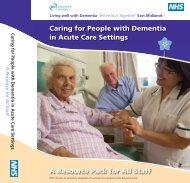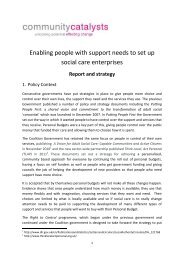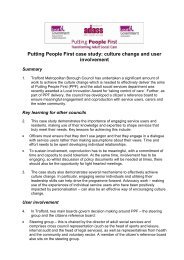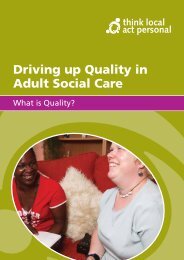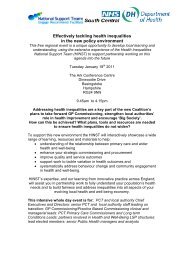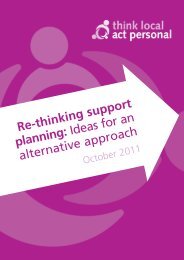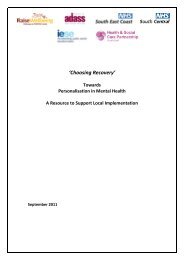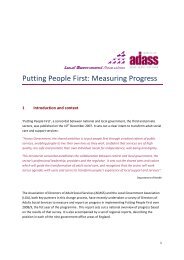Practical approaches to safeguarding and personalisation (pdf ...
Practical approaches to safeguarding and personalisation (pdf ...
Practical approaches to safeguarding and personalisation (pdf ...
Create successful ePaper yourself
Turn your PDF publications into a flip-book with our unique Google optimized e-Paper software.
<strong>Practical</strong> <strong>approaches</strong> <strong>to</strong> <strong>safeguarding</strong> <strong>and</strong> <strong>personalisation</strong><br />
Case Study: My keeping safe plan<br />
Warwickshire County Council has developed a <strong>to</strong>ol <strong>to</strong> use with cus<strong>to</strong>mers during the “set up”<br />
of their direct payment. The <strong>to</strong>ol is an example of co-production <strong>and</strong> was developed by<br />
cus<strong>to</strong>mers, front line practitioners <strong>and</strong> staff from the Rowan Organisation (provider of the<br />
direct payment support service in Warwickshire).<br />
Its purpose is <strong>to</strong> support the cus<strong>to</strong>mer through a process which identifies what support is<br />
available <strong>and</strong> how it can be accessed <strong>and</strong> results in a document which is of practical use <strong>to</strong> the<br />
cus<strong>to</strong>mer.<br />
The <strong>to</strong>ol provides a framework for discussion between the care worker <strong>and</strong> the cus<strong>to</strong>mer <strong>and</strong><br />
for the provision of information which will support the successful management of the direct<br />
payment <strong>and</strong> mitigation of risk. The plan covers:<br />
1. Managing the direct payment account<br />
2. Recruitment (including use of CRB checks)<br />
3. Responsibilities as an employer (including references, contracts, insurance)<br />
4. Training needs <strong>and</strong> plan (for the cus<strong>to</strong>mer <strong>and</strong> for personal assistants)<br />
5. When things go wrong<br />
6. Who can help me (contact sheet which includes a <strong>safeguarding</strong> helpline number)<br />
6. Outcomes review<br />
The council must check at appropriate intervals whether the support plan is achieving the<br />
appropriate outcomes for the individual. Reviews must be timed <strong>to</strong> reflect the relative risks<br />
<strong>and</strong> the possibility of significant changes. The review should focus on outcomes not<br />
processes, <strong>and</strong> look at what is working well <strong>and</strong> what is not working well for the individual.<br />
The design of the outcomes review process is an integral part of the risk management process<br />
for the council. Depending on what is agreed at the review, changes can be made <strong>to</strong> the<br />
resources, support or controls described in the support plan. Reviews are therefore a crucial<br />
part of <strong>safeguarding</strong>, <strong>and</strong> need <strong>to</strong> be carried out effectively.<br />
Councils should invest in effective person-centred ‘reviewing’ training, so that staff who<br />
review by visits, by phone calls, or by observation, know what questions <strong>to</strong> ask <strong>and</strong> know<br />
how <strong>to</strong> notice when things are not going well. Some people will need more frequent reviews<br />
than others – for example if they are particularly isolated or lack mental capacity. Social care<br />
skills are needed rather than simply auditing ones, as the ultimate aim is <strong>to</strong> strengthen the<br />
ability of the person <strong>to</strong> achieve the outcomes they want.<br />
A project by Lincolnshire Social Services found that –<br />
19



